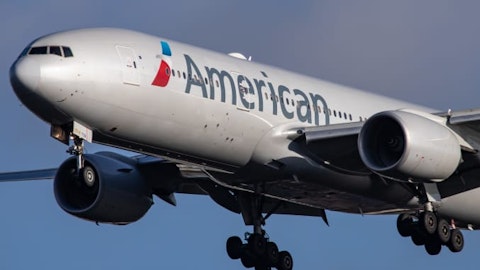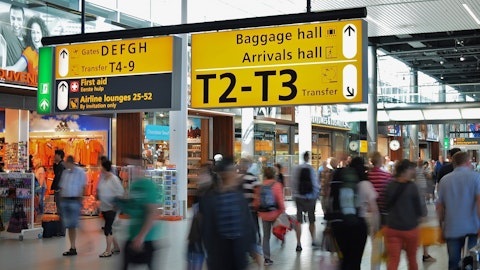Operator: Our next question comes from Savi Syth with Raymond James.
Savanthi Syth: Hey, thanks for the follow-up. Just first one just on the — to follow up on Cathy’s question, just on the charter how — is that the significant portion of the breakeven earnings outlook or are you just not really including it until you have a better idea of how that ramps up?
Wade Steel: Yes, Savi. This is Wade. So for 2023, we do not anticipate significant profitability as we are growing that entity. We are going to be doing maintenance events to get airplanes ready, training pilots and so that is not a major driver in the overall breakeven for our for SkyWest Inc.
Savanthi Syth: Got it. And then if I just might ask a bit of a slightly longer-term question, just based on the kind of the revised contracts that you’ve gotten, the fact that you have more E175s than you had in 2019, I was just wondering if you can kind of compare it to your level of profitability in 2019 and kind of once we get back to — if you’re able to kind of fully utilize your fleet, could you just talk about like maybe the things that are positive or negative versus your 2019 earnings? Really like what’s going to be better than and what’s going to be maybe a little not-so-great?
Chip Childs: Yeah, I think — Savi, this is Chip, just real quick, I think there is some comparability on the 175 fleet on a unit basis once we get the utilization levels that we want, that could be very comparable from a profitability perspective. I think that we continue to have — we continue to manage the fleet in a way that I think is going to be very good from a cost perspective, and I think, again, we just — on the CRJ fleet we have a 30% gap we got to overcome, which is purely non capital investment very accretive block hours that we just have to start to get to the point where we can fly. So I don’t doubt that that is going to be that different from 2019. The other element relative to what else was contributing to that as the CRJ fleet, particularly on the prorate side as well.
Obviously we pulled out a significant amount of prorate relative to what’s happened in 2022. I will be very clear on the call that that was higher margin than what our contract margins were, despite with some entities in the United States think that we’re not making money in small towns and are pulling out, that’s absolutely false. These flying prorate an essential air service was very good profitability. So to the extent that we compare where we were in 2019, I would have to say, it depends on what we can do relative to the non-ERJ and dual class CRJ fleet relative to Charter and/or other essential air service models. Now, the flip side of that also Savi, and you don’t hear the big guys talking much about this, so we will certainly talk about it, is the fact that throughout the pandemic since 2019, small city demand has — travel has just exploded.
We get a lot of calls. It’s not us calling somebody else, we get a tremendous amount of calls from local cities and states and everywhere that are also nonessential service flying, wanting us to find ways to serve their cities. So certainly the deurbanization throughout the pandemic has gone — put demand back in our favor, even in a pre-2019 level. So from our perspective, like I say, we’ve got a great balance sheet, we’ve got great assets. We’re just going to continue to be patient and deliberate about taking care of our people in a way in which we can get our utilization on our fleet back up and then be more strategic about what we can do with partners and additional aircraft or shifting some of that stuff around later, but we got a lot of — we got a lot of runway left to get utilization — accretive utilization back up before we get to that time.
So hopefully that’s a helpful perspective.
Savanthi Syth: That is. Thanks. Chip
Operator: Our final question comes from Michael Linenberg with Deutsche Bank.
Michael Linenberg: Yeah, hey, I just actually two here. Thanks for giving me the follow-up. I just want to go back to the fact that you haven’t been able to — you kind of closed deals with, I guess you said the majority of your partners. I don’t know if that’s one or two, you said 60% to 70% covered, Chip, is there anything that we should read into that or is it just timing that it just takes time to do each of these deals or is there some read through here?
Chip Childs: I think I think mostly just timing, honestly, Michael, I think that we continue to have great dialog with all of our partners. That’s the fun part about our job is collaborating and finding ways that works to do business with both of us or all of us, all four of us and some are more aggressive than others and some are more patients than others, and I don’t think there’s anything to be read into it. I think if there is we will probably be updating in the next quarter or the quarter after. But we’re optimistic that they’re all thinking of the same lines, the fact that we can offer incredibly good product that is predictable and reliable, and stable and we try to do all we can to make their lives easy and they I think recognize that very clearly. And as we work toward long-term sustainability, I think that we’re very optimistic about all of our partnerships.
Michael Linenberg: Okay, that’s great. And then just my second. Thanks for giving us kind of a sense of your capacity to grow without adding shells. I think you mentioned by 2024, that you could add 30% block hour increase on the ERJ fleet without adding any additional shells and 40% on the CRJs, you only have a few airplanes coming over the next few years, is the right way to think about it that you’re really not planning to take delivery of anything beyond what you have order for the next several years. Is that how we should think about like — is that the planning for the next 2 to 3 years, it’s just a few units, it’s all about stabilization
Chip Childs: Yeah, this is Chip again. I would agree with that Michael, only from the perspective that it’s going to take a lot to get that utilization back. I would reiterate, we are having conversations with manufacturers and certainly creative conversations about long-term ESG and fleets and so there’s a lot of conversations about fleet. There’s a lot of that conversation with our partners, but there’s just too much opportunity until we close off that gap of that utilization before we get serious about it. The other thing is, I mean, you’ve got a couple of other things running against this. You’ve got higher interest rates, airplanes are expensive. And so from our perspective, it’s not that we’re not looking down the road of continuing to grow the fleet.
It’s more like, let’s be focused on making sure we get the accretion without unnecessary investment first and then which by today if we’re talking the timeframe that we’ve talked about over the last little bit. We should we need to pay attention to adding additional fleet because it takes a while to make aircraft. So I think it’s rather fluid and we’ll keep you up to speed in the upcoming quarters about that, but we haven’t put the conversation on ice, we’re continuing the conversation. We just, it’s more important to get the utilization up.
Michael Linenberg: Okay, great. Thanks, Chip. Thanks everyone.
Operator: There are no further questions at this time. I’ll now turn the call back over to CEO Mr. Chip Childs thanks
Chip Childs : Thanks, Devin. We appreciate your help with the call today. It’s been a — 2022 is a very exciting and eventful year. I will reiterate what said in the script and throughout the call, I think that we’re in a fantastic position to continue to capitalize on what SkyWest is about, what things we have going for us and we’re going to continue to be disciplined and work towards making sure that we take care of all the stakeholders at SkyWest. Again, one more thanks out to the amazing people at SkyWest and all the work that they do every single day to provide this reliability and we look forward to talking to next quarter. Thank you.
Follow Skywest Inc (NASDAQ:SKYW)
Follow Skywest Inc (NASDAQ:SKYW)
Receive real-time insider trading and news alerts





